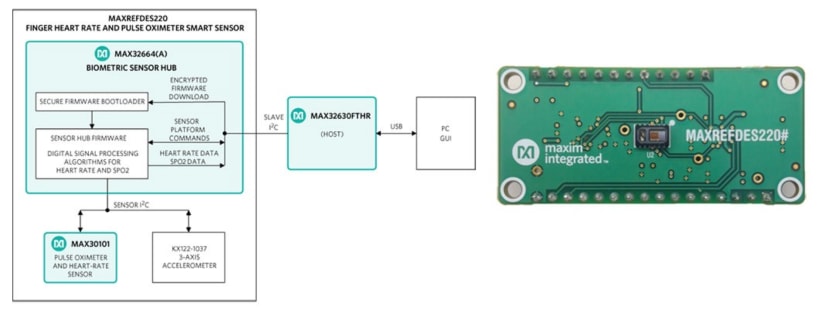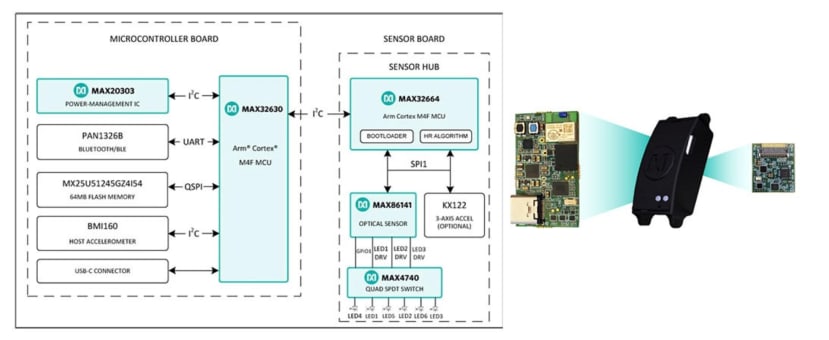Reference designs for wearable healthcare applications from Maxim Integrated
Follow articleHow do you feel about this article? Help us to provide better content for you.
Thank you! Your feedback has been received.
There was a problem submitting your feedback, please try again later.
What do you think of this article?
From FitBit fitness trackers to heart monitors, the demand for wearable health devices continues to grow. According to the latest report from Gartner, worldwide end-user is forecasted to spend US$81.5 billion in 2021, demonstrating an 18.1% increase compared to 2020. These devices allow monitoring of patient’s health by continuously measuring vital parameters with wide variety of sensing technologies, from stand-alone temperature sensors to highly integrated sensor ICs.
Although designing wearable devices brings its own set of challenges and constraints, we are seeing more and more solutions from semiconductor suppliers that are aimed at supporting engineers from the ideation stage to an end product.
In this article, we explore reference designs dedicated to wearable healthcare applications that are offered by Maxim Integrated. These designs are available for download in DesignSpark PCB format (in conjunction with Ultra Librarian).
MAXREF220: Finger Heart Rate and Pulse Oximeter Smart Sensor with Digital Signal Processing
The MAXREFDES200# reference design is ideal for quick prototyping and evaluation of healthcare applications that involve finger-based heart rate, blood oxygen saturation level (SpO2), and blood pressure trending (BPT) measurements. It features the MAX30101 (191-4219) pulse and heart-rate sensor and ultra-low power MAX32644 (version A) (198-2206) biometric sensor hub.
Figure 1. MAXREFDES220
MAX30101
The MAX30101 sensor IC integrates pulse oximeter and heart-rate sensor into a tiny (5.6mmx3.3mmx1.55mm) optical module. The device relies on the reflectance-based photoplethysmography (PPG) technique, where the LED pulses are passed through the skin and a photodetector is used to detect the light that reflected off the tissues and bones. The MAX30101 also integrates a glass cover for optimal, robust performance.
MAX32644A
The MAX32644 sensor hub family allows seamless integration of Maxim’s optical sensors into fully functioning, real-world wearable applications. The raw or calculated data from the sensors can be delivered to the outside world without compromising on the overall system power consumption. Version A of MAX32644 is designed to communicate with the MAX30101 via the I2C interface and to perform heart rate and blood oxygen saturation (SpO2) monitoring from finger-based measurements. The device embeds advanced algorithms, such as digital filtering, pressure and position compensation and advanced R-wave detection, to calculate the heart rate in beats per minute. The ambient light rejection has been built into sensor hardware with the purpose of minimizing background noise.
MAXREF103: Wrist-Based SpO2, HR, and HRV Health Sensor Platform
Unlike the previous reference design, the MAXREFDES103# (223-6442) focuses on applications that utilize wrist-based measurements of health parameters, such as oxygen saturation, heart rate and heart rate variability (HRV). The platform integrates C version of MAX32664 biometric sensor hub, which includes an algorithm for heart rate and SpO2based on PPG signals received from the MAX86141 analog-front-end (AFE) sensor.
Figure 2. MAXREFDES103
MAX86141
The MAX86141 (223-6437) AFE sensor is optimized for both transmissive and reflective pulse oximeter and heart-rate monitoring with three programmable LED drivers and two optical readout channels. It features a built-in algorithm for addressing fast ambient transients and can achieve up to 70dB ambient rejection at 120Hz. Another version of MAX86141 device with a single readout channel, MAX86140 (223-6441) (191-4228) , is also available, and both devices share the same footprint and are supplied in a wafer-level package (WLP) (2.048 x 1.848mm) with 0.4mm ball pitch.
MAX32644C
The MAX32664 Version C relies on SPI interface for communication with the MAX86141 to collect heart rate and blood oxygen saturation (SpO2) readings from the patient’s wrist. The algorithms that are embedded into the MAX32633C are digital filtering, distance and motion compensation and advanced R-wave detection.
Reference design – MAXREFDES103
MAXREF104: Health Sensor Platform 3.0
The latest generation of Maxim’s health sensor platforms, the MAXREFDES104 integrates advanced sensors, including MAX86176 analog-front-end (AFE) sensor, a MAX30208 (193-8421) human body temperature sensor and a 3-axis accelerometer, for use in use in medical and fitness applications. The platform enables the measurement of physical parameters, such as skin temperature, heart rate (HR), oxygen saturation (SpO2), biopotential measurements (ECG) as well as motion.
Figure 3. MAXREFDES104
MAX86176
The MAX86176 is a two-in-one photoplethysmogram (PPG) and electrocardiogram (ECG) analog front-end (AFE) solution for wearable applications. It features an ECG channel, EMI filtering, internal-lead biasing, AC and DC lead-off detection, right-leg drive, ultra-low power DC lead-on detection during standby mode, and extensive calibration voltages for built-in self-test.
MAX30208
The MAX30208 (193-8421) temperature sensor is ideal for battery-operated applications with a low operating current of 70µA. It also offers ±0.1°C accuracy over a wider temperature range (30°C to 50°C). The MAX30208 uses a standard I2C serial interface to communicate with a host controller.
Reference design – MAXREFDES104
To find out more about these and other products and solutions from Maxim Integrated, follow our Healthcare page.




